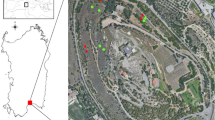Abstract
The recovery process of a Sasa tsuboiana population after a mass flowering and death in 1977 was investigated by 15 years of observation in the Hira Mountains, Kinki district, western Japan. Seed production was high (6600–13 800 seeds m−2 in Sasa plots and 3900 seeds m−2 in a forest plot) but emergent seedling density was low (14–21 seedlings m−2), probably because of seed predation by Microtus montebelli occurring between seed shedding and the next spring. The seedling density had decreased further by the next year and the S. tsuboiana population recovered from only a limited number of seedlings. In spite of such a low initial density, the S. tsuboiana population was able to regenerate successfully and attained the previous full stand height in 7–16 years. Miscantbus sinensis invaded and delayed the recovery of S. tsuboiana in one plot, but S. tsuboiana became dominant as it caught up with the height of M. sinensis. Seedling growth patterns, such as frequent tillering, the onset of rhizome extension in the early stage of seedling growth and frequent culm production from rhizomes, played important roles in the successful regeneration of S. tsuboiana.
Similar content being viewed by others
References
Campbell, J. J. N. (1985) Bamboo flowering patterns: A global view with special reference to East Asia. J. Am. Bamboo Soc. 6: 17–35.
Hokkaido Regional Forestry Office (1981) A research on the Sasa population after natural withering. In: Distribution of Sasa Groups and Their Characteristics in the Jurisdiction of Hokkaido Regional Forestry Office, pp. 21–59. Hokkaido Regional Forestry Office (in Japanese).
Iriguchi M. (1975) Flowering and fruiting of Sasa. Bull. Hiroshima For. Exp. Sta. 10: 63–5 (in Japanese).
Ito T. (1975) Outbreaks of the field vole, Microtus montebelli, in Kansai and Chugoku districts. Bull. Gov. For. Exp. Sta. 271: 39–92 (in Japanese with English summary).
Janzen D. H. (1976) Why bamboos wait so long to flower. Ann. Rev. Ecol. Syst. 7: 347–91.
Kobayashi K. (1979) Studies of the growth and maintenance of patch of Miscantbus sinensis Anderss. I. Dynamics of shoot population and its relationships to expansion of patch area. Jpn. J. Ecol. 29: 397–401.
Konno Y. (1977) Ecology of the Sasa grassland on Mt. Hohrai. In: Reports of Natural Environmental Research of Biwako Valley, pp. 37–48. Biwako Valley Co. (in Japanese).
Kudoh, H. & Ujiie M. (1990) Regeneration of Sasa kurilensis and tree invasion after mass flowering. Bamboo J. 8: 38–49.
Kuwahata T. (1979) Independence of the 1977 ourbreak of Japanese vole (Microtus montebelli) on the Mts. Hira, Shiga prefecture to the contemporary fruiting of Ibuki-zasa (Sasa tsuboiana), Forest Pests 28: 42–6 (in Japanese).
Makita A. (1992) Survivorship of a monocarpic bamboo grass, Sasa kurilensis, during the early regeneration process after mass flowering. Ecol. Res. 7: 245–54.
Makita A., Konno Y., Fujita N., Takada K., Hamabata E. & Mihara T. (1988) Mass flowering of Sasa tsuboiana in Hira Mountains. Bamboo J. 6: 14–21 (in Japanese with English summary).
Mizushima S. (1977) Relation between outbreaks of the Murid rodents and mass seeding of Sasa and trees. Nonezumi 142: 80–3 (in Japanese).
Mohri K. (1976) Mass flowering and fruiting of Sasa kurilensis in Hitsujigaoka, Hokkaido. Hoppoh Ringyo 28: 104–5 (in japanese).
Murata G. (1977) Plants of Biwako Valley. In: Reports of Natural Environment Research of Biwako Valley, pp. 13–35. Biwako Valley Co. (in Japanese).
Nakashizuka T. (1988) Regeneration of beech (Fagus crenata) after the simultaneous death of undergrowing dwarf bamboo (Sasa kurilensis). Ecol. Res. 3: 21–35.
Shibanuma I., Hashizume H. & Kondo Y. (1977) Fundamental studies on the growth and regeneration of Sasa tectorius Makino. Bull. Tottori Univ. For. 10: 1–12 (in Japanese with English summary).
Simmonds N. W. (1980) Monocarpy, calendars and flowering cycles in Angiosperms. Kew Bull. 35: 235–45.
Suzuki S. (1978) Index to Japanese Bambusaceae. Gakken, Tokyo.
Tang Y. H., Washitani I., Tsuchiya T. & Iwaki H. (1988). Fluctuation of photosynthetic photon flux density within a Miscanthus sinensis canopy. Ecol. Res. 3: 253–66.
Taylor A. H. & Qin Z. (1988) Regeneration from seed of Sinarundinaria fangiana, a bamboo, in the Wolong Giant Panda Reserve, Sichuan, China. Am. J. Bot. 75: 1065–73.
Ueda K. (1961) On the flowering and death of bamboos and the proper treatment. (II) Relation between the flowering bamboo and a rhizome system in the bamboo grove with non flowering bamboo. Bull. Kyoto Univ. For. 33: 1–26 (in Japanese with English summary).
Veblen T. T. (1982) Growth patterns of Chusquea bamboos in the understory of Chilean Nothofagus forests and their influences in forest dynamics. Bull. Torrey Bot. Club 109: 474–87.
Yamanaka M. (1979) Revegetation of Sasa ishizuchiana community after the mass death in Ishizuchi Mountains. In: Conservation Report of Mt. Ishizuchi and Omogo-Valley in Ishizuchi Quasi-National Park, Shikoku, pp. 65–73. Nature Conservation Society of Japan (in Japanese).
Yano N. & Sakaguchi Y. (1987) Observation on the succession of community of Pleioblastus distichus var. glaber after the wholesale death in Higashi Otafukuyama. In: Papers on Plant Ecology and Taxonomy to the Memories of Dr. Satoshi Nakanishi, pp. 393–403. The Kobe Geobotanical Society (in Japanese with English summary).
Author information
Authors and Affiliations
About this article
Cite this article
Makita, A., Konno, Y., Fujita, N. et al. Recovery of a Sasa tsuboiana population after mass flowering and death. Ecol. Res. 8, 215–224 (1993). https://doi.org/10.1007/BF02348534
Accepted:
Published:
Issue Date:
DOI: https://doi.org/10.1007/BF02348534




